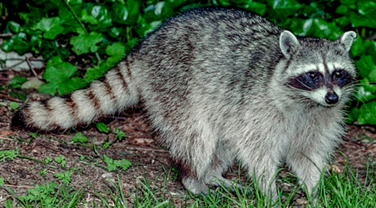Ken Baker: Raccoons go from cute kits to outrageous adults

With the possible exception of a certain overly aggressive red squirrel who tried to bite off a couple of my fingers at the elbow, the meanest animal I ever worked with was a small, but surprisingly strong, female raccoon.
Well, perhaps mean really isn’t the right word. I’d probably voice my annoyance too, if some lout were to trap me, cover my body in a burlap sack with just my head sticking out, and fix a leather collar bearing a radio-transmitter around my neck. So, seriously displeased, then.
On the other hand, the most outrageously adorable creature was a month-old raccoon kit.
And that captures the enigma of this intriguing, comical, and frequently troublesome mammal. A star of countless funniest animals videos on YouTube and, all too often, the beloved family pet rescued by the kids as an orphaned baby … who turns vicious as an adult, savaging the living room before clawing his way out of the house through a window screen.

Captain John Smith, leader of the Virginia Colony at Jamestown in 1609, named the species “aroughcun” in his journals after the Powhatan term for “animal that scratches with its hands.” It’s an apt name since the raccoon’s hyper-sensitive front paws are the source of its most important sense — more crucial to its daily survival than its keen sense of hearing and smell (or somewhat less acute vision).
Raccoons are known for handling, washing their food
Almost two-thirds of the sensory perception area of a raccoon’s brain is devoted to tactile inputs, primarily from its front paws, more than has been observed for any other animal. Virtually every food item is handled and inspected before being eaten.
Which brings up the issue of dousing and the species’ scientific name, Procyon lotor.
You can find plenty of websites that refer to the raccoon’s dousing — washing — its food prior to consuming it. In fact, its species name, lotor, comes from the Latin for “laundryman.” Even so, behavioral biologists have largely discredited this still widely held belief for over 40 years.
Raccoons are omnivores, opportunists who dine on a wide variety of plant and animal foods. Adept climbers, they are one of the most important predators on bird eggs and nestlings. They rarely take much larger prey, however, preferring easier to catch and overcome quarry like insects, amphibians and, one of their top favorites, crayfish.
They search for crayfish and other aquatic invertebrates (as well as fish if they can snag one) by dabbling their front paws about in the shallows at the edge of a stream. Raccoons are primarily nocturnal, but their sense of touch is so keen, they don’t rely much on vision when dabbling and are still effective predators even on moonless, black-as-pitch nights.
Although captive raccoons have been observed to carry food to a nearby stream, it’s now thought the behavior is triggered by an innate drive for dabbling rather than a desire to cleanse the food. This is supported by the observations that captive animals will dunk aquatic prey items more frequently than terrestrial prey, and that wild raccoons have never been seen to carry a prey item to a stream for a wash.
Procyon lotor’s original habitat was the deciduous and mixed forests of eastern North America. However, raccoons have shown themselves to be highly adaptable to changes in their environment, and are now found from southern Canada, throughout most of the U.S. and Central America, and into the northern portions of South America — wherever there are enough trees to serve as refuges and nesting sites.
Show in Japan resulted in 1,500 rascals being imported in the 1970s
They have acclimated well to agricultural, marshland, small town, and even large urban areas, with sizeable populations now residing in New York City, Washington D.C., and Chicago. They have also been released — sometimes accidentally, sometimes intentionally — in much of Europe and Asia, where they have commonly become a problem for native species.
In the late 1970s, for example, 1,500 raccoons were imported into Japan as a result of the popularity of an anime series titled Rascal the Raccoon. They are now found in all 47 of the country’s Prefectures where they annually cause many thousands of dollars in damage and negatively impact the wildlife.
It is true that raccoons can carry rabies. In fact, of 6,940 documented cases of rabies found in animals in the U.S. in 2006, almost 38% had been seen in raccoons. It’s noteworthy, however, that only one human death due to rabies contracted from a raccoon has ever been reported here (in 2003).
The viral disease, distemper (which is not transferrable to humans), is much more of a problem for raccoons. While hunting, trapping and vehicular collisions are the most common sources of raccoon mortality, distemper is their most frequent natural cause of death.
Although raccoons have been reported to live up to 16 years in the wild, most don’t survive past their second year. If one does somehow manage to make it that far, it can look forward to an average lifespan of about five years.
Ken Baker is a retired professor of biology and environmental studies. If you have a natural history topic you would like Dr. Baker to consider for an upcoming column, please email your idea to fre-newsdesk@gannett.com.
This article originally appeared on Fremont News-Messenger: Raccoons go from cute kits to outrageous adults
